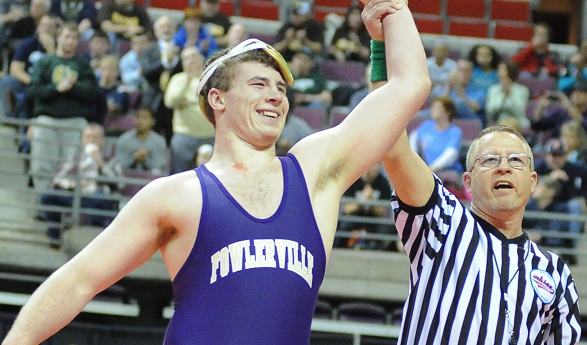
Standard Bearer of a 4-Time Champ
March 2, 2013
By Geoff Kimmerly
Second Half editor
AUBURN HILLS – Adam Coon attended the MHSAA Individual Finals for the first time as a seventh grader, the son of a successful coach who knew what it took to grow a champion.
And Adam hoped to become one too. But he really wanted to know what it took to become the wrestler who carried the American flag during the athletes’ Grand March before the matches began.
“I told him the guys up there are the best in the state. So you’re probably going to have to be a four-timer,” Fowlerville coach Dan Coon recalled. “You better show yourself that you’re a four-timer and worthy to carry the American flag.”
Adam Coon did carry the flag into The Palace of Auburn Hills before Saturday’s Individual Finals. And only a few minutes later, he became just the 17th MHSAA wrestler to finish his high school career with a championship won every season.
Coon pinned Eaton Rapids senior Trent Hurd in 1:13 to win the championship at 285 pounds and finish this winter 55-0. He pinned every opponent he faced this season, and ended with a career record of 211-3 – with a 194-match winning streak dating to his freshman year that ranks as seventh-longest in MHSAA history.
All four of Coon’s championships came at either 285 or 215 pounds, making him also the first of that elite group to win his four at the heaviest weights.
Carrying in the flag was “a dream comes true.” But winning the titles was pretty great too.
“Since I got that first one, I was going to see if I could get the fourth,” Coon said. “I just got the opportunity, and I took advantage of it. Praise God, I got the fourth.”
Dan Coon has been the one to keep Adam grounded, especially with pressure mounting this season. Before they took the mat Saturday, Dad reminded son of something he’d heard: “The sun will always rise tomorrow. Just a whole lot brighter when you win.”
Adam’s other childhood dream had been to get a lot closer to seeing what that bright sun looks like. He’ll study aerospace engineering while wrestling at the University of Michigan, and has been set on designing a spacecraft to accommodate taller astronauts since finding out as a child that he’d probably end up too sizable to make the trip.
Dan is looking forward to watching what his son will accomplish next, be it on the mat or beyond while using the lessons he learned during these championship runs.
“Is he going to stop wrestling? No. It will never leave him now,” Dan Coon said. “He’s always going to be a wrestler.”
Eaton Rapids’ Hurd finished 43-12. Click for full results, and read below for recaps of each championship match and comments from all the winners.
103
Champion: Joe Garcia, Adrian, Jr. (31-1)
Fall, 2:53, over Ian Parker, St. Johns, Fr. (48-3)
Garcia was the MHSAA runner-up in 2011. He then came in fifth at his weight in 2012 – but didn’t get that longed-for chance to return to the championship match and come away with a win.
Until Saturday. An offseason of increased preparation and conditioning and a switch in strategy from that freshman Final gave him the edge to win his first MHSAA title.
“It lets me know my hard work paid off,” Garcia said. “My freshman year, I was more focused on defense. And this year, I focused more on the attack. I didn’t stop moving.”
112
Champion: Mason Smith, Clio, Soph. (55-4)
Fall, 3:30, over Zeth Dean, Lowell, Fr. (40-6)
Smith felt pretty good about his chances of coming into his first season, 2011-12, and winning an MHSAA championship. And he nearly got that opportunity, before finishing fourth at 103 pounds.
Now, thanks to some push by his coaches, he feels set up to make a run at finishing with three titles instead.
“Last year, I was really lazy. I didn’t want to do anything. I thought I’d just win,” Smith said. “My coach came at me pretty hard, all of them. None of them let me just sit around and do nothing like I did last year.
“(Now,) I’m going to come back hard and go for it.”
119
Champion: Bailey Jack, Lowell, Jr. (39-8)
Decision, 6-4, over Dean Somers, Lapeer West, Sr. (46-2)
Only 56 wrestlers in Michigan can say they finished the season with an Individual Finals win. And Jack will take it, especially coming off the disappointment of his Red Arrows losing to St. Johns in the Team Final a week ago.
Jack offered praise for Somers, a runner-up in 2012 – “He’s tough everywhere. You don’t make it to the Finals being a sissy,” – and thankful for the jumpstart he received to prepare for next winter.
“It’s a great bounce-back, morally, for me,” Jack said. “Now I can go into the offseason working just as hard as I did this year.”
125
Champion: Zac Hall, St. Johns, Jr. (48-0)
Technical Fall, 23-8, over JacQuan Moore, St. Clair Shores Lakeshore, Sr. (44-4)
Over the course of just a few minutes Saturday, Zac Hall put himself on the cusp of making some incredible history next season.
Not only will Hall be shooting to become the 18th wrestler to win four MHSAA championships. He’ll also try to become perhaps only the second (more research to come) to win four individual titles and wrestle for four team champions as well.
Hall had previously won his individual titles at 112 and 103. Davison’s Brent Metcalf won individual titles from 2002-05 and was on team champions as well all four seasons.
“One kid’s ever done it, so that’s a pretty incredible class to be put with,” Hall said. “(But) you get here at the Palace, anything can happen. … You’ve just got to be smart, keep your head.
“I had three matches where I thought I was going to pin the kid. Kids fight at another level when you get here. They don’t get easier.”
130
Champion: Jacob Schmitt, St. Johns, Sr. (51-0)
Fall, 0:47, Christian Schoenherr, Bay City Western, Soph. (42-8)
Schmitt admitted his final high school season flew by this winter. He’ll continue to wrestle at the college level – for Northwestern – but first has finished a legacy that stacks up with the best.
He capped the weekend with his third MHSAA individual title – he also won 103 in 2010 and 125 last season – to go with four team championships. Schmitt also was runner-up at 112 as a sophomore.
“It went quick this year, but I’m happy with the way I went out. With a pin in the first period, I couldn’t be happier,” he said. “I would say (this season) started out rough for us, with those losses. (St. Johns finished 22-4). But we kept it together as a team, pulled through at the end, great teammates pushing each other all the time.”
135
Champion: Logan Massa, St. Johns, Soph. (42-2)
Fall, 2:45, over Steve Bleise, Chelsea, Jr. (45-1)
Massa knew something about competing in an MHSAA Final – he finished runner-up at 119 last season. But the coach in his corner knew a little bit more.
Brother Taylor Massa returned to The Palace to sit in Logan’s corner, a year after the former finished his high school career as the 16th to win four MHSAA titles.
“He’s knows the environment real well. He helps me out a lot,” Logan said.
“I wasn’t going to let (last year) happen again. I trained harder, and I was just going to train as hard as I could until I got it.”
140
Champion: Kyle Simaz, Allegan, Jr. (61-1)
Major Decision, 22-13, over Adam Nichols, Lapeer West, Sr. (50-5)
“We got one folks; good deal,” a relieved Simaz said after capping his third MHSAA Finals appearance with his first win.
Simaz had finished runner-up at 130 pounds last season and at 119 in 2011. And not long into Saturday’s championship match, Nichols nearly pinned him.
But by staying on his feet – Simaz’s strength – he turned the tide of the match quickly in his favor.
“I was really disappointed to start the match off like that. That’s a bad note. But luckily we came though that and pulled off a victory,” Simaz said.
“I’ve been waiting a long time to get one of these, so I’m very relieved. I feel like a lot of stuff came off my shoulders.”
145
Champion: Ben Whitford, St. Johns, Sr. (37-0)
Technical Fall, 22-7, over Casey Burandt, Niles, Sr. (31-2)
Whitford also celebrated winning a fourth state-level championship Saturday. He clinched his second MHSAA title to go with his championship last season at 140 and two he won while living in Illinois as a freshman and sophomore.
He keeps up with some friends he wrestled with while in Illinois. But he’s definitely a Michigan guy now, and signed to join U-M next season.
“It’s a weird feeling that it’s all over,” Whitford said. “For the last two years, I don’t think I would’ve improved more, had better friends, or been able to do the things we’ve done without the guys around me. And I’m just proud to be back in St. Johns.”
152
Champion: Josh Pennell, St. Johns, Sr. (40-0)
Fall, 1:44, over Fritzel Findeisen, Niles, Sr. (49-6)
Pennell has been a significant part of St. Johns’ program through all four team championships, and finished third individually the last two seasons after placing second at 119 as a freshman.
But the Michigan State recruit felt like it was inevitable that like many of his teammates, he’d get an individual title too. And in his final high school match, he made that hope come true.
“It’s long overdue, I felt like. And what a better year than senior year,” Pennell said. “I wasn’t going to stop until I had a state title.
“I thought about (the last few years) a lot. I was able to come back and wrestle and win my match for third. Those were all very close matches, and all I thought about was winning it and winning those close matches.”
160
Champion: Devon Pingel, North Branch, Fr. (40-3)
Decision, 10-5, over Jordan Sullivan, Coopersville, Sr. (39-3)
Pingel explained that he’d wrestled on a similarly large stage before –prior to high school, when he won a tournament in Tulsa, Okla.
But he was excited about the opportunities that could come with finishing his first trip to The Palace with an MHSAA title as a freshman.
“I learned to push myself a lot harder,” Pingel said. “I wanted to be a four-time state champ. I got a start to it.”
171
Champion: Angus Arthur, St. Johns, Soph. (46-3)
Decision, 5-2, over Brett Dempsey, Mattawan, Sr. (55-1)
It’s fair to say Arthur, for one of the few times this season, was the underdog in his championship match. Dempsey finished third at 171 in 2012 and hadn't lost this winter.
But it’s been a fun two weeks for the Redwings, given their team title won in Battle Creek. And Arthur felt confidence in the preparation he’d received facing some of the toughest teams in the state this season.
“I felt like I was (the underdog). (But) I didn't really look at the record,” he said. “I knew I could win, and I just went out there.”
189
Champion: Payne Hayden, St. Johns, Sr. (45-1)
11-9, Decision, over Garett Stehley, Lowell, Jr. (30-1)
For once, Hayden said, he felt “great” at the end of an MHSAA Finals.
He’d had plenty of success before, making the Semifinals his first two seasons and finishing runner-up at 215 a year ago. But ending number one was an entirely different experience.
“Every year, I’ve had seven losses no matter what age. (But) I’ve always been right at the top of the podium,” Hayden said. “It feels good right now to finally get that chip off my shoulder.”
Hayden finished undefeated in Michigan this winter. His lone loss came to Lakewood (Ohio) St. Edward’s Domenic Abounader, who he’ll wrestle with next season at U-M.
215
Champion: Brian Moran, Fowlerville, Sr. (56-0)
Decision, 11-5, over Taylor Kornoely, Lowell, Sr. (36-1)
The unfortunate circumstance of Saturday’s final Division 2 match was that one senior was going to finish his final season with a loss and just shy of winning his first MHSAA title.
Moran led 6-4 with a period remaining before pulling away. And the emotion of the moment wasn’t lost on the Gladiators’ standout, who lost to teammate Adam Coon at this weight in the 2010 championship match and finished fourth at his weight last season.
“Since I’ve been in fourth grade, I’ve put my heart and soul in this sport. And to leave this sport at that type of note, on top, it’s amazing," Moran said. "I’ve been striving for this my whole high school career. I don’t care if it’s a state title. I feel like I just won the Olympics."
PHOTO: Fowlerville senior Adam Coon has his arm raised after winning his fourth MHSAA title Saturday at The Palace of Auburn Hills. (Click to see more at HighSchoolSportsScene.com.)
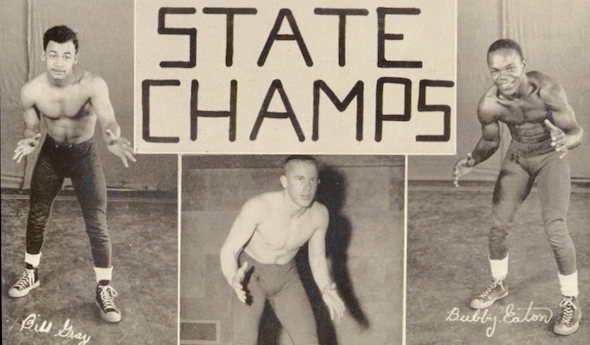
Old 5-A League Fueled Wrestling's Rise
June 29, 2020
By Ron Pesch
Special for Second Half
This latest quest into wrestling began with an inquiry, as these projects often do.
My work with the MHSAA – which includes the title ‘historian’ – is mostly a hobby that began many years ago. The diversion often gets me into press boxes and places the average sports fan doesn’t usually get to venture. Now and then, I get to talk into a microphone. But mostly, it is hours of digging; pouring through scrapbooks, yearbooks and newspapers, old and new, as I search for names, details and stories lost in time. The pursuit sometimes leads to awkward phone calls, e-mails and messages where I try to describe who I am and why I’m chasing a phone number for someone, a person’s mother or father, grandmother or grandfather.
I adore the chase and resolving mysteries. I love visiting libraries and schools and delight in connecting with people. I love filling in holes and connecting dots. I’m a computer guy by trade, focused on analyzing and aligning data. I equate sports searches to detective work, and for fans of old television, I’m like Columbo without the trench coat or cigar, always asking, “Just one more thing …”
Wrestling
My first visit to the sport was in junior high gym class. That’s when Coach Murphy paired me up against another undersized classmate. With the shrill of a whistle, we battled it out on a deep red colored mat – representative of one half of the red and grey school colors of Nelson Junior High. The struggle lasted for no more than a matter of seconds. With a slap of a mat, or perhaps another whistle, it was over. I lost by ‘fall’ – the gentler way of saying I was pinned.
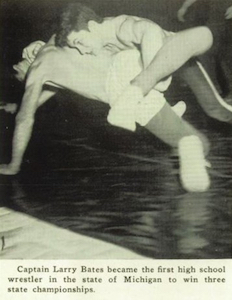 My second visit to the sport came in high school. That’s when the wrestling coach stopped me in the hall one day to suggest I join the wrestling team. Apparently, word of the skills I demonstrated at Nelson hadn’t travelled the half mile east from the junior high to the high school. Quickly recognizing this fact, I told him it might be counter-productive, as I wasn’t much of a wrestler. He was undeterred. Because I was still undersized, he said, I would likely win a fair number of matches. Many schools, it seemed, struggled to find someone to wrestle in the lower classes, and hence, would have to forfeit. I still turned him down.
My second visit to the sport came in high school. That’s when the wrestling coach stopped me in the hall one day to suggest I join the wrestling team. Apparently, word of the skills I demonstrated at Nelson hadn’t travelled the half mile east from the junior high to the high school. Quickly recognizing this fact, I told him it might be counter-productive, as I wasn’t much of a wrestler. He was undeterred. Because I was still undersized, he said, I would likely win a fair number of matches. Many schools, it seemed, struggled to find someone to wrestle in the lower classes, and hence, would have to forfeit. I still turned him down.
I give credit to the Coach Erickson. He was trying to involve a kid in athletics that wasn’t going to make the football, basketball or track team. But that bit of wisdom didn’t hit me until long after high school.
As the above may demonstrate, an extensive understanding of the intricate particulars of wrestling isn’t my strong suit. I’ve attended only one MHSAA Wrestling Final. That visit still remains among my favorite sports sights. The pageantry of the Grand March staged before the orchestrated pandemonium of the MHSAA wrestling championship combined with huge crowds and inspiring athleticism creates a spectacular event.
The Latest Project
Recently, a question, relating to past individual champions from the earliest days of the championships, arrived at the MHSAA office. The Association has awarded wrestling titles since 1948, and a list of team champions and runners-up from the beginning to the present appear on the MHSAA Website. Missing, however, are the names of the individuals who won championships between 1948 and 1960.
To find an answer, that meant a deep dive into newspapers, yearbooks and old wrestling guides to exhume the particulars from articles and agate, cross-referencing results, matching last names to first names, correcting spellings and occasionally schools when obvious errors have been made.
Technology has helped carve away some time and travel when embarking on such a project. Once, the only way to dig out such information was to travel to microfilm, and then spend hours scrolling past print. Today, thanks to some online archives, even during a global pandemic, we can visit a handful of Michigan newspapers via the internet. Tack on the ability to search the online cloud of information, intriguing elements intermittently bubble to the surface, transforming a standing list of names and schools to an account that brings at least some names to life.
The Beginnings
An initial look at the existing team championship listings revealed the first fact. For all intents and purposes, the earliest days of the MHSAA wrestling state championships served as a glorified meet for the members of the 5-A Conference. The league, comprised of Ann Arbor, Battle Creek Central, Jackson, Lansing Eastern and Lansing Sexton high schools, was where wrestling as a prep sport first gained traction in Michigan. Almost immediately, Greater Lansing established a stronghold on the sport that would last those first 13 years.
From 1948 to 1960, there was only one classification in which all schools, regardless of size, competed. In 10 of those 13 years, one of two Lansing high schools – Eastern or Sexton – won the state’s mat championship. In the three years when a Lansing team didn’t win, they finished as runner-up. Those three were part seven total of that baker’s dozen when either Eastern or Sexton finished second.
Growth in Michigan
The first championship tournament in 1948 involved around a dozen schools. While expansion into other schools commenced slowly, by 1957, wrestling had progressed into the fastest growing sport in Michigan.
“The sport blossoms into many new schools every year,” stated George Maskin in a January issue of the Detroit Times in 1957. “Best estimates are that at least 60 varsity prep teams now are in competition. The figure should come close to the 100 mark within a year or two. Prep wrestling has grown with such swiftness it now is necessary to hold regionals to determine qualifiers for the state meet.
“It is not the kind of wrestling one has watched on television or in some of the professional arenas around the state,” he added, trying to educate the public about the difference between the prep sport and the form of broadcast entertainment then popular. “Groans and grunts have no part in high school wrestling … nor does hair pulling or stamping the feet … or pointing a finger into the referee’s eye.”
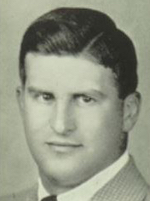 Coaches of wrestling noted that it was one of the few sports offered that gave equal opportunity to students regardless of their physical build. Separated into 12 weight classifications, running from 95 pounds and under up to the unlimited, or heavyweight division, there was a place for all.
Coaches of wrestling noted that it was one of the few sports offered that gave equal opportunity to students regardless of their physical build. Separated into 12 weight classifications, running from 95 pounds and under up to the unlimited, or heavyweight division, there was a place for all.
“Take the kid who weighs 95 pounds,” Ignatius ‘Iggy’ Konrad, a former wrestler at Michigan State and the coach at Lansing Sexton, told Maskin. “He’ll participate against a boy of similar weight. Thus a kid whose athletic possibilities might appear hopeless (in other sports) finds a place for himself in wrestling.”
As the sport continued to expand, coaches were still trying to explain the worth.
“Parents should try to understand the difference between television wrestling and high school and college wrestling,” Grandville coach Kay Hutsell told a Grand Rapids Press reporter in December 1960. “There is no comparison. TV is 100 percent acting.”
A state champion wrestler as a high school student in Illinois, where spectator interest and participation was far greater than in those early days of wrestling in Michigan, Hutsell twice lettered in the sport at Indiana University.
“Wrestling is a conditioner and perhaps develops the body better than any other sport. About the only way wrestling can educate the adults (in the western Michigan area about the sport) is through newspapers.” He felt people should come to “see for themselves.”
The Tournament
Lansing Sexton won the state’s inaugural team wrestling title, 54-43 over the Ann Arbor Pioneers, with the event run off on the mats of the University of Michigan in 1948. Both Floyd Eaton at 127 pounds and Carl Covert at 133 ended the year undefeated for the Big Reds. Five wrestlers from each school earned individual titles that first year. Jackson’s heavyweight, Norm Blank, scored a pin over Sexton’s Dick Buckmaster. The pair had split their two previous matches during league competition.
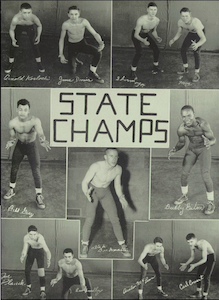 Ann Arbor grabbed the next two MHSAA team titles, both by a mere four points, first 60-56 over Sexton, then topping the Quakers of Lansing Eastern, 56-52, in 1950.
Ann Arbor grabbed the next two MHSAA team titles, both by a mere four points, first 60-56 over Sexton, then topping the Quakers of Lansing Eastern, 56-52, in 1950.
Eight wrestlers qualified for the final round for both Ann Arbor and Sexton in 1949, with five each earning championships. Both schools had three wrestlers finish in third and fourth place; hence the team title was awarded based on Ann Arbor tallying more pins. A total of 96 wrestlers from 11 schools participated in the tournament. Ted Lennox, wrestling at 95 pounds, became the first athlete from the Michigan School for the Blind to compete for an individual title but was defeated by Sexton’s Leo Kosloski. Lennox would later wrestle for Michigan State.
In 1950, nine Ann Arbor wrestlers advanced to the final round with six seizing championship medals, but only Sam Holloway repeated as champion from the previous year. Teammate Jack Townsley, who had won in 1949 at 112 pounds, finished second at 120.
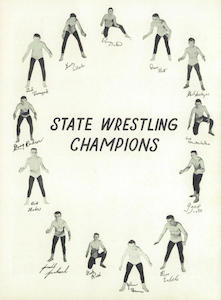 Eastern and coach Don Johnson grabbed the first of two consecutive titles in 1951, topping Ann Arbor, 56-52, with East Lansing finishing a distant third with 26 points. Pete Christ of Battle Creek Central became the first Bearcat (and only the second athlete from a school other than Eastern, Sexton or Ann Arbor) to bring home an individual wrestling title, with a decision over Lansing Eastern’s Vince Malcongi in the 140 classification. “The Bearcat matmen took fourth in the State,” according to the Battle Creek yearbook. “Mr. Donald Cooper took over the coaching duties when Mr. Allen Bush was called to the Marines.” (Bush would later serve as executive director of the MHSAA).
Eastern and coach Don Johnson grabbed the first of two consecutive titles in 1951, topping Ann Arbor, 56-52, with East Lansing finishing a distant third with 26 points. Pete Christ of Battle Creek Central became the first Bearcat (and only the second athlete from a school other than Eastern, Sexton or Ann Arbor) to bring home an individual wrestling title, with a decision over Lansing Eastern’s Vince Malcongi in the 140 classification. “The Bearcat matmen took fourth in the State,” according to the Battle Creek yearbook. “Mr. Donald Cooper took over the coaching duties when Mr. Allen Bush was called to the Marines.” (Bush would later serve as executive director of the MHSAA).
Johnson’s squad absolutely dominated the field in 1952, topping Sexton the next year, 68-43. Ann Arbor followed with 39 points. Seven Quakers – George Smith (95), Herb Austin (103), Jim Sinadinos (127) Bob Ovenhouse (133), Bob Ballard (138), Ed Cary (145) and Norm Thomas (175) – all won their final matches. Both Austin and Sinadinos were repeat champions.
Sexton flipped the table in 1953 with a 67-46 win over Eastern. Ten Big Reds competed for individual state championships among the 12 classifications, with five taking home titles. The Big Reds’ Ken Maidlow, jumping from 165 pounds to 175, and Eastern’s Ed Cary, who moved up to 154, both repeated as medal winners. In the heavyweight class, Sexton’s Ray Reglin downed Steve Zervas from Hazel Park. (Zervas, a two-time runner-up, later wrestled at the University of Michigan, then coached wrestling at Warren Fitzgerald for 34 seasons and served as mayor of Hazel Park from 1974 to 1986).
In 1954, Ossie Elliott of Ypsilanti and Henry Henson of Berkley became the first wrestlers from non 5-A schools to win individual state wrestling titles. Elliott, who had finished as state runner-up in 1953 at 133 pounds, downed Lansing Sexton’s Tom Holden in the same classification. Henson earned a decision over Lansing Eastern’s Ken Bliesener at 154 pounds. Eastern again returned to the winner’s circle, outdistancing Sexton, 60-44. Ypsilanti finished third with 34 points.
By 1955, athletes from 28 high school teams were battling for state team and individual honors on the mats at MSC’s Jenison Field House. As a senior captain, Lansing Eastern’s Larry Bates pinned four out of five opponents in the 112-pound class to become Michigan’s first wrestler to earn three state crowns. Bates grabbed his first title in 1953, competing at 95 pounds, followed by his second in 1954 at 103. Eastern picked up its second-straight team trophy, racking up 102 points on the way to a fourth crown in the eighth year of championships. For the first time, a non-5-A school finished second, as the Ypsilanti Braves grabbed runner-up honors with 84 points.
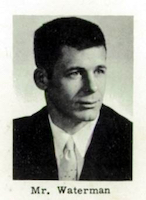 Coach Bert Waterman led Ypsilanti to the first of four championships during a 10-year span in 1956. Two Braves, Ambi Wilbanks and Walt Pipps, earned titles while three others finished second in their classifications. Ypsi had lost one dual meet during the regular season, to Lansing Eastern, by a slim three-point margin. With the 1967-68 school year, Waterman would embark on a 24-year career as coach at Yale University after posting a 192-35-4 mark in 16 seasons at Ypsilanti. A 1950 graduate of Michigan State, the former Spartans wrestler would join Eastern’s Don Johnson, Sexton’s Iggy Konrad, Fran Hetherington from the School for the Blind and two other high school coaches as a charter member of the Michigan Wrestling Hall of Fame in November 1978.
Coach Bert Waterman led Ypsilanti to the first of four championships during a 10-year span in 1956. Two Braves, Ambi Wilbanks and Walt Pipps, earned titles while three others finished second in their classifications. Ypsi had lost one dual meet during the regular season, to Lansing Eastern, by a slim three-point margin. With the 1967-68 school year, Waterman would embark on a 24-year career as coach at Yale University after posting a 192-35-4 mark in 16 seasons at Ypsilanti. A 1950 graduate of Michigan State, the former Spartans wrestler would join Eastern’s Don Johnson, Sexton’s Iggy Konrad, Fran Hetherington from the School for the Blind and two other high school coaches as a charter member of the Michigan Wrestling Hall of Fame in November 1978.
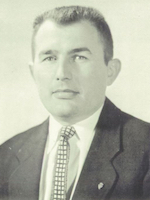 Runner-up in 1956, Eastern grabbed another title in 1957 topping Battle Creek Central, 93-89, in the tournament standings. It was a surprise “going away present” for Coach Don Johnson, who was stepping away after 10 seasons of coaching the Quakers to accept the assistant principal position at Eastern. Battle Creek had five wrestlers advance, and held a 56-48 lead over Eastern as the teams entered the final round. The Quakers’ Ted Hartman opened the day with a victory in the 98-pound weight class, helping Eastern post a 3-1 record in championship round matches. Sexton assisted with the Eastern victory when Norm Young defeated Battle Creek’s Bob McClenney in the 120 weight class. The Bearcats, who had five wrestlers in the finals, ended with two individual champs on the day and their highest finish in their 10 seasons of wrestling.
Runner-up in 1956, Eastern grabbed another title in 1957 topping Battle Creek Central, 93-89, in the tournament standings. It was a surprise “going away present” for Coach Don Johnson, who was stepping away after 10 seasons of coaching the Quakers to accept the assistant principal position at Eastern. Battle Creek had five wrestlers advance, and held a 56-48 lead over Eastern as the teams entered the final round. The Quakers’ Ted Hartman opened the day with a victory in the 98-pound weight class, helping Eastern post a 3-1 record in championship round matches. Sexton assisted with the Eastern victory when Norm Young defeated Battle Creek’s Bob McClenney in the 120 weight class. The Bearcats, who had five wrestlers in the finals, ended with two individual champs on the day and their highest finish in their 10 seasons of wrestling.
An All-American wrestler at Michigan State, Johnson would remain at Eastern throughout his education career, retiring as principal in 1983. The fieldhouse at Eastern was named after him in December 1984, fittingly just prior to the championship round of the annual Eastern High Wrestling Invitational.
Eastern again went back-to-back, topping Sexton, 88-57, with Ypsilanti third in the 1958 championship standings. The meet, culminating with 16 boys competing in each weight division – four each from regionals hosted at Battle Creek, Lansing, Ypsilanti and Berkley – was held at the Intramural Building at the University of Michigan. Both Eastern and Sexton advanced four wrestlers to the final round, with Eastern’s Gary Gogarn (95), Ron Parkinson (145) and Alex Valcanoff (154) earning titles. For Sexton, Fritz Kellerman (133) and Wilkie Hopkins (138) finished on top.
The 1959 championships, hosted at the new intramural building at MSU, found boys from 47 schools chasing medal honors.
“Points toward the team title are awarded one for each bout won, with an extra point for a fall,” noted the Lansing State Journal, explaining the mechanics of the tournament. “The big scoring chance comes (in the final round) with a first place netting 10 points, second 7, third 4 and fourth 2.”
Jackson and Sexton had tied for the 6-A Conference crown (the league renamed with the addition of Kalamazoo Central to the mix) and the race to the MHSAA title was expected to be a tight one. Jackson qualified seven for the semifinal round, with four advancing to the championships. The Big Reds sent five wrestlers to the last round. Vikings Ron Shavers (95), Nate Haehnle (145) and Don Mains (165) had each won matches, while Sexton’s qualifiers Tom Mulder (127) and Emerson Boles (175) had earned titles.
With one match remaining, Jackson trailed Iggy Konrad’s Big Reds by four, 67-63, as the Vikings’ Ed Youngs – the state’s reigning heavyweight champion – squared off with Sexton’s Mickey Devoe. Youngs grabbed a 3-1 decision to repeat, but the Vikings needed a fall in the match for a tie. Hence, the Big Reds eked out a single-point victory, 74-73, to escape with their third state mat title.
The results of the title round of the 1960 tournament, also won by Sexton, telegraphed how far the sport had come. Wrestlers from a dozen high schools squared off for honors in the title matches, with winners representing 10 cities. The Big Reds topped Ypsilanti 70-64, followed by Kalamazoo Central with 56 points. Eight other schools had scored at least 20 points in the tournament; 31 teams had scored at least a point. Tom Mulder of Sexton was the lone repeat champion.
With 112 schools now offering wrestling on their sports menu, the MHSAA split the event into two parts for the 1959-60 school year, with Class A set for the University of Michigan and Class B hosted by Michigan State University. The sport was now in full bloom.
 Ron Pesch has taken an active role in researching the history of MHSAA events since 1985 and began writing for MHSAA Finals programs in 1986, adding additional features and "flashbacks" in 1992. He inherited the title of MHSAA historian from the late Dick Kishpaugh following the 1993-94 school year, and resides in Muskegon. Contact him at [email protected] with ideas for historical articles.
Ron Pesch has taken an active role in researching the history of MHSAA events since 1985 and began writing for MHSAA Finals programs in 1986, adding additional features and "flashbacks" in 1992. He inherited the title of MHSAA historian from the late Dick Kishpaugh following the 1993-94 school year, and resides in Muskegon. Contact him at [email protected] with ideas for historical articles.
PHOTOS: (Top and 4) Lansing Sexton won the first MHSAA Finals in wrestling in 1948. (2) Eastern’s Larry Bates became the first three-time individual champion in MHSAA history in 1955. (3) The Big Reds were led by coach Ignatius Konrad. (5) Lansing Eastern kept the championship in the capital city in 1949. (6) Bert Waterman built one of the state’s top programs at Ypsilanti. (7) Don Johnson was the architect of Eastern’s program.(Photos gathered by Ron Pesch.)

